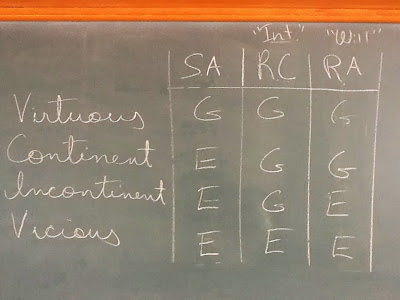The other day in my philosophical psychology course I was teaching my students the differences and mutual relations between (a) sense appetite, (b) the practical intellect, and (c) the will or rational appetite. I brought up Aquinas' understanding of Aristotle's concept of continence (enkrateia) and incontinence (akrasia) from his Commentary on Aristotle's Nicomachean Ethics, Book 7, which I think illustrates well these differences and relations. When the question came up of what exactly is the difference between the virtuous man, the continent man, the incontinent man, and the vicious man, I felt suddenly illuminated and saw myself come up with this nice, clean chart which illustrates the differences. The ensuing discussion was quite interesting.
The three columns state whether each of the four characters (virtuous, continent, incontinent, and vicious) is inclined towards good (G) or evil (E) by the sense appetite (SA), the intellect or practical reason ('R' is for rational, and 'C' is for cognitive), and the will ('R' is for rational, and 'A' is for appetitive). So the chart says that the virtuous man is inclined towards good both by his sense appetite and by his (practical) reason, and that he actually chooses good with his will. The continent man is like the virtuous man, except his sense appetite does not incline him towards the good that he knows and chooses, so there is a certain tension within him: he acts against his sense appetite. The incontinent man, like the continent man, is inclined towards evil by his sense appetite and yet is capable of knowing the good that he ought to do through practical reason, but unlike the continent man, he chooses evil. Finally, the vicious man is inclined towards evil, rationalizes his evildoing through practical reason, and chooses evil--in at least one respect he is like the virtuous man, namely, in that there is a certain harmony among his powers, albeit a perverse one.
This may be a somewhat simplistic view of Aquinas' doctrine, but I think it captures the basics pretty well.



.jpg)






